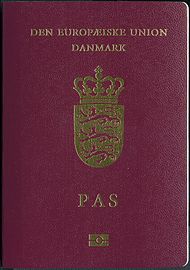Danish passport
| Danish passport | |
|---|---|

The front cover of a contemporary Danish biometric passport
|
|
| Date first issued | 1 August 2006 (current biometric version) |
| Issued by |
|
| Type of document | Passport |
| Purpose | Identification |
| Eligibility requirements | Citizens of the Kingdom of Denmark |
| Expiration | 28 months for children up to the age of 1 64 months for citizens aged 2–17 124 months for individuals above the age of 18 (All passports can be renewed for 12 more months within 24 months of original expiration date) |
Danish passports are issued to citizens of the Kingdom of Denmark (Danish: Kongeriget Danmark) to facilitate international travel.
Different versions exist for nationals of Denmark, Greenland and the Faroe Islands although all citizens have the same nationality. Danish nationals residing in Greenland and the Faroe Islands can choose between the Danish EU passport and the local (Greenlandic or Faroese) non-EU passport.
Every Danish citizen (except for those residing in the Faroe Islands) is also a citizen of the European Union. The passport entitles its bearer to freedom of movement in the European Economic Area and Switzerland as provided in Directive 2004/38/EC.
According to the 2016 Visa Restrictions Index, Danish citizens can visit 174 countries without a visa or with a visa granted on arrival.
The Danish and Greenlandic versions of the passport have burgundy colour covers, according to the European Union's recommendations, while the Faroese version is green. All contain the Danish Coat of Arms emblazoned in the centre of the front cover, with the word DANMARK (Denmark) above it, and the word PAS (Passport) below. Since 1 August 2006, biometric passports are issued. Above the word DANMARK, the Danish version contains the words DEN EUROPÆISKE UNION (European Union) (as all other EU passports), while in the Greenlandic and Faroese versions the text KALAALLIT NUNAAT (Greenland) or FØROYAR (Faroe Islands) is written. Fields on the bearer's page are in Danish, English and French, with translations in the official languages of the European Union elsewhere in the document. Instead of French, Faroese or Greenlandic are used in the Faroese and Greenlandic versions respectively. The page contains the following information:
...
Wikipedia
